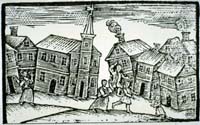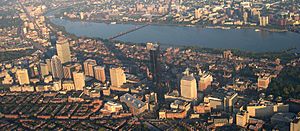1755 Cape Ann earthquake facts for kids
| USGS-ANSS | ComCat |
|---|---|
| Local date | November 18, 1755 |
| Local time | 04:30 |
| Magnitude | 5.9 Mw |
| Epicenter | 42°42′N 70°12′W / 42.7°N 70.2°W |
| Areas affected | British America, Province of Massachusetts Bay |
| Max. intensity | VIII (Severe) |
The 1755 Cape Ann earthquake happened off the coast of what is now Massachusetts on November 18, 1755. It was a very strong earthquake, measuring between 6.0 and 6.3 on the Richter scale. This scale measures how powerful an earthquake is. It is still the biggest earthquake ever recorded in Massachusetts.
Even though it was powerful, no one died. However, it damaged many buildings in the city of Boston. People felt the shaking far away, from Nova Scotia in the north to South Carolina in the south. Sailors on a ship more than 200 miles (320 km) out at sea felt it too. They thought their ship had hit the bottom! Many people in Boston at the time believed God caused the earthquake. This made them more religious for a short time. Today, experts think a similar earthquake would cause about $5 billion in damage and hundreds of deaths in Boston. Some scientists wonder if this earthquake was linked to a much larger one that happened in Lisbon, Portugal, a few weeks earlier.
Where the Earthquake Started
The earthquake happened on November 18, 1755, around 4:30 AM. John Adams, who later became a President of the United States, was at his father's house in Braintree, Massachusetts. The quake woke him up. He was so amazed that he started writing a diary that very night.
He wrote that the shaking lasted "near four minutes." He also said his house "seemed to rock and reel and crack." It felt like it would fall apart. Scientists believe the earthquake started in the ocean. This spot was about 24 miles (39 km) east of Cape Ann.
People felt the earthquake in many places. It reached Halifax, Nova Scotia, in the north. It was felt as far south as the Chesapeake Bay and South Carolina. To the west, it reached Lake George and Lake Champlain. Even a ship 200 miles (320 km) off the east coast felt the quake. The sailors on that ship thought they had run aground because the shaking was so strong.
After the main earthquake, there were several smaller shakes called aftershocks. The first aftershock happened just over an hour later. Most of these aftershocks were not felt in Boston. They mostly affected the northeastern coast of the colony.
Modern studies estimate the quake was between 6.0 and 6.3 on the Richter scale. The United States Geological Survey says it's the biggest earthquake in Massachusetts history. Scientists are still not sure what causes earthquakes in the northeastern United States. There are many old faults (cracks in the Earth's crust) in the area. But none of them are known to be active today. It's possible the Cape Ann earthquake was triggered by the huge 1755 Lisbon earthquake in Portugal. However, there isn't enough proof to say for sure.
What Damage Occurred
The cities of Boston and Cape Ann had the most damage. In Boston, the damage was worse in areas built on "infill." Infill is land created by filling in water bodies, like parts of the harbor. This type of land is not as strong as natural land during an earthquake.
Between 1,300 and 1,600 chimneys in Boston were damaged. Some parts of houses, like the gable ends (the triangular part of a wall under a sloping roof), fell down. Many roofs were also damaged by falling chimneys. Stone chimneys and buildings were damaged in Falmouth (now Portland, Maine), Springfield, Massachusetts, and New Haven, Connecticut. Some church steeples in Boston became tilted. Stone fences in the countryside also broke.
People also reported other strange things. Several natural springs dried up, and new ones appeared. Cracks opened in the ground near Scituate, Lancaster, and Pembroke. In Pembroke, people saw water and fine sand coming out of the cracks.
Damage to things inside houses was minor. People reported broken dishes and glasses. One person who made alcohol lost some of their product when a large container broke. The Cape Ann earthquake might have also caused the first recorded tsunami in U.S. history. A tsunami is a giant ocean wave caused by an earthquake. People in the Leeward Islands, nearly 1,000 miles (1,600 km) south of Cape Ann, saw the water pull back. Then a huge wave came in. It lifted several boats onto the shore and left fish flopping on the beach.
How the Earthquake Changed Things
Many people in Massachusetts at the time thought the earthquake was a punishment from God. They believed it was because of bad behavior. After the earthquake, special prayer services were held. City leaders even announced "fast days," when people would go without food for religious reasons.
Many religious speeches and writings were published. These included Verses Occasioned by the Earthquakes in the Month of November, 1755 by Jeremiah Newland. Another was Earthquakes the Works of God and Tokens of his Just Displeasure by Thomas Prince.
However, not everyone believed it was only God's work. By 1755, new scientific ideas from the Age of Enlightenment were influencing educated people. John Winthrop, a professor at Harvard University, offered a different idea. He thought earthquakes were caused by heat and gases inside the Earth.
John Adams, in his notes on Winthrop's ideas, wondered if people naturally thought disasters were punishments. He also questioned if this idea came from religion. He wrote that it's "far from being true" that these events are only for punishing sinners. This kind of public discussion between religious leaders and scientists was very risky in Massachusetts back then. It was only 65 years after the Salem witch trials, when people were punished for beliefs that went against common ideas.
Since 1755, Boston and its nearby towns have grown into a huge city. Many new buildings have been built on infill, especially in the Back Bay area. These areas might shake more during an earthquake. The sand and gravel used as fill could also settle. Many older buildings in Boston are made of stone and brick. These could easily collapse in a major earthquake.
Because of this, experts today worry about what another big earthquake would do to Boston. A study in 1990 by the Massachusetts Emergency Management Agency estimated the damage could be between $4 billion and $5 billion. They also thought hundreds of lives could be lost. As a result, the state has updated its building rules. New buildings in risky areas must now be built to resist earthquakes.
The risk of earthquakes in the area was also discussed when the Seabrook Station Nuclear Power Plant was being built. This plant is about 15 miles (24 km) north of Cape Ann in New Hampshire. Despite the concerns, the plant was built.



